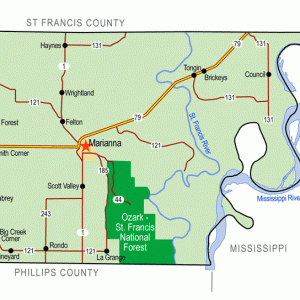calsfoundation@cals.org
LaGrange (Lee County)
| Latitude and Longitude: | 34°39’23″N 090°43’58″W |
| Elevation: | 217 feet |
| Area: | 0.15 square miles (2020 Census) |
| Population: | 52 (2020 Census) |
| Incorporation Date: | July 24, 1984 |
Historical Population as per the U.S. Census:
|
1810 |
1820 |
1830 |
1840 |
1850 |
1860 |
1870 |
1880 |
1890 |
1900 |
|
– |
– |
– |
– |
– |
– |
– |
– |
– |
– |
|
1910 |
1920 |
1930 |
1940 |
1950 |
1960 |
1970 |
1980 |
1990 |
2000 |
|
– |
– |
– |
– |
– |
– |
– |
– |
108 |
122 |
|
2010 |
2020 |
|
|
|
|
|
|
|
|
|
89 |
52 |
|
|
|
|
|
|
|
|
LaGrange is a town in southern Lee County, between Marianna (Lee County) and Helena-West Helena (Phillips County). It is near the St. Francis National Forest’s lands that include the southern portion of Crowley’s Ridge.
LaGrange appears to be one of the earliest settlements in the area; its French name translates as “the farm.” Settlers were already present when the first government land grant was given to Jonathan Howell in 1820. New Hope Baptist Church was founded at LaGrange in 1848, and a Methodist church also was built before the Civil War. A U.S. post office was established in 1852. At this time, LaGrange was in Phillips County, as Lee County was not created until 1873.
By the time of the Civil War, LaGrange had six stores, two churches, a Masonic lodge, a school, and several homes. This prosperity made the settlement a target of Federal forces, leading to skirmishes at LaGrange on September 6 and 26, 1862, and November 1 and 8, 1862. Federal units active in the area included the First Missouri Cavalry, the Fifth Kansas Cavalry, and the Fourth Iowa Cavalry, among others. The number of soldiers wounded and killed is unknown, although one death was reported for the September 26 skirmish. No Confederate reports exist for these skirmishes, which is hardly surprising, since it appears that at least two of the three events were skirmishes between Federal units who had failed to recognize each other and had attacked, according to official reports, “by mistake.” The settlement of LaGrange itself was repeatedly raided by Federal troops, who reportedly mixed together all the medicines and poisons from the drugstore, leaving local residents to care for their medical needs with self-obtained herbal remedies for the duration of the war. Some of the leading Confederate sympathizers of LaGrange were imprisoned in Helena for a time.
The school, the Methodist church, and several homes and businesses were reestablished after the war. Among the prominent citizens of LaGrange were Charles and Lucy Adams, who were the grandparents of famed deaf and blind author Helen Keller. Keller, who was born and raised in Alabama, is not known to have visited Arkansas, although the family members did remain in touch with one another.
Around 1880, the Helena and Iron Mountain Railroad built a line connecting Helena to Marianna that passed through LaGrange. A railroad depot was built, and additional stores opened. The settlement, still unincorporated, was a popular stop on the railroad, which soon became part of the Missouri Pacific Railway. The two-room schoolhouse was used as a community center some evenings and weekends, hosting plays, dances, ice cream socials, and boxed lunch auctions, as well as the occasional political speech. The schoolhouse held first through eighth grades, with high school students riding the train to Marianna for classes. Community records mention African-American residents—including Jesse Buford, a prominent wood carver—but they do not say where the Black children were educated.
Railroad traffic ceased through the settlement in 1960. The Methodist congregation merged with that of Haynes (Lee County), although the building continued to be used for some time for Methodist services and revivals. The school was closed, with children (white and Black) bused to Marianna.
LaGrange, however, did not disappear, as did so many similar settlements in the Delta. Instead, the community incorporated as a town in 1984, presumably to establish services such as paved roads, and a water and sewage system. The population grew from 108 to 122 between 1990 and 2000, but then declined to eighty-nine by the 2010 census. That census reported fifty-one white residents and thirty-six Black residents. At that time, the only business existing in the town was the post office.
For additional information:
Lee County Sesquicentennial Committee. Lee County History. Dallas, TX: Curtis Media Company, 1987.
Steven Teske
Butler Center for Arkansas Studies
 Lee County Map
Lee County Map 



Comments
No comments on this entry yet.